- Submissions

Full Text
Archaeology & Anthropology:Open Access
Petrography and Geochemistry of Ore-Bearing Granites and Pegmatites from Bastar Craton, Central India
Yamuna Singh*
Formerly with Atomic Minerals Directorate for Exploration and Research, India
*Corresponding author: Yamuna Singh, Centre for Earth, Ocean and Atmospheric Sciences, University of Hyderabad, Gachibowli, P.O. Central University, Hyderabad, India
Submission: July 02, 2018;Published: October 04, 201858

ISSN: 2577-1949 Volume3 Issue2
Abstract
FThe granite-pegmatite systems of the Bastar craton, central India host polymetallic Nb,Ta,Sn,Be,Li ore deposits, which are genetically related to various granitic bodies locally called the Paliam-, Darba-, Metapal- and Kawadgaon-granites. In addition, limited occurrences of Rare Earth Elements (REE) are also known. Generally, the granites and associated pegmatite aureoles locally show physical continuity, suggesting that the pegmatites are late magmatic injections. Field observation shows that unzoned pegmatites occur as veins and fracture fillings within biotite granite. The granites comprise chiefly of quartz, microcline, perthite, albite-oligoclase, with muscovite, biotite and (secondary) hydrated muscovite, sericite, and chlorite as accessories. In addition, zircon, rutile, xenotime, sphene, ilmenite, magnetite, zoisite, and clinozoisite are also present. Occasionally, the granites host pale yellow euhedral monazite crystals displaying a brown dotted pigmentation. The dominance of primary muscovite over biotite in the granites suggests that they are peraluminous.
Chemically, the bulk of granites fall in the compositional field for granite. The granites are highly peraluminous (A/CNK ratio>1; 1.05-1.25), and distinctly enriched in Rb, Y, Nb, Pb and depleted in Sr and Ba. In terms of the molar A/CNK vs. A/NK plots, the granites fall in the field for S-type granites. The available geochemical data indicates that the peraluminous pluton was appreciably influenced by feldspar fractionation. The available high initial 87Sr/86Sr isotopic ratios, including mol. CaO/(MgO+FeOt) vs. mol. Al2O3/(MgO+FeOt) plots, of the granites also indicate that the granitic bodies were derived from the reworking of the older crustal rocks involving metapelite and metagreywacke sources in the generation of the magmas.
Keywords: Geochemistry; Ore-bearing granites and pegmatites; Bastar craton; Central India
Introduction
The Himalayan foredeep basin formed on the Paleozoic through early Cenozoic Tethyan continental margin of the Indian Plate [1,2]. The Cretaceous-Paleocene sedimentary basin (Tansen Basin), located in the southern part of the Lesser Himalaya, deposited on an eroded surface of Precambrian basement of the Lesser Himalaya [3,4]. The foreland basin sequences of the Nepal Himalaya are mostly continental deposits (some marine beds) developed first in a passive-margin setting [1] succeeded by detritus from the collision of the Indian plate with the Asian plate about ca.60-50Ma [5]. Although some recent studies have suggested that the initial India-Asia collision took place at ~34Ma [6-9], whereas Najman et al. [10] suggests the terminal collision of India with Asia took place at 54Ma.
Geological Setting
The regional geological setting of the Bastar craton is available in various publications [8-11]. The oldest lithologies in the area are granitic gneisses of the Sukma Group [12], which formed at 2636-2528Ma [13]. The gneisses contain metamorphosed enclaves of mafic and ultramafic rocks represented by hornblende schists and tremolite-actinolite-talc-chlorite schists (Figure 1). The gneisses are overlain by the sheared, ferruginised, and silicified metasedimentary sequence of the Bengpal Group, as well as amphibolites [14]. Paleoproterozoic granites, namely, the Paliam-, Darba-, Katekalyan-, and Kawadgaon-granites, have intruded the Sukma Gneisses and metasedimentary rocks of the Bengpal Group. The Kawadgaon granite yielded an Rb-Sr, whole-rock isochron age of 2497±152Ma (error at 2 sigma level), with an initial 87Sr/86Sr ratio of 0.7142 [14]. The granite of the Kawadgaon appears to be older than granites of the Paliam and Darba areas in the southeastern part of the Bastar craton (2308±48Ma) [10]. Furthermore, in the eastern part of the Bastar craton, granite of similar age (2301±53Ma) [15] is reported from Cholanguda. Still younger felsic phases (i.e., leucogranite) are known from the Barsur (2101±323Ma) [13] and Pujariguda (2110±47Ma) [15] granites in the Bastar craton. It is thus apparent that the Bastar craton has witnessed various pulses of granitic magmatism. The granitic activity in the Bastar craton over the period from 2300-2100Ma [14] is also considered to be a major tectonothermal event in the central Indian Tectonic Zone [16].
Figure 1:Location of Bastar craton in relation to inset map of India. (b) Location of Bastar-Malkanjgiri pegmatite belt (BMPB) in a part of the Bastar craton. (c) Geological map of BMPB of the Bastar craton, central India [8-12].
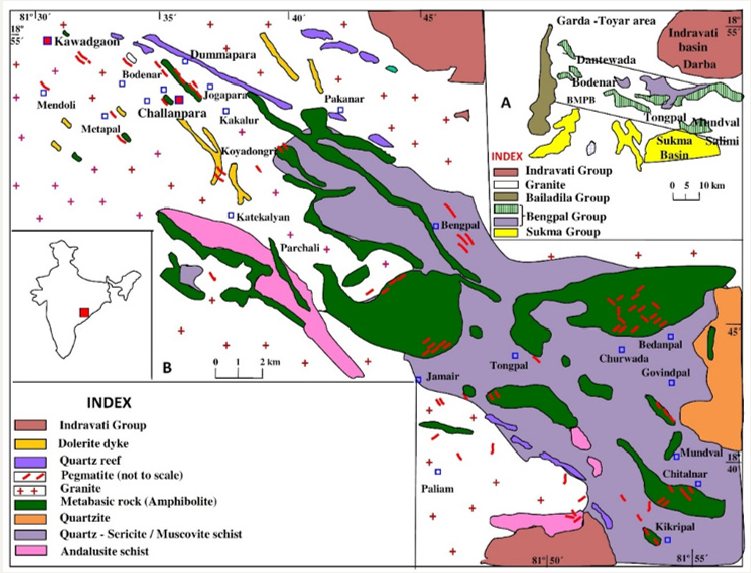
Petrography and Geochemistry of Ore-Bearing Granites and Pegmatites
Field observations
The granites (~2.5-2.1Ga) in Bastar craton occurs in the form of low lying hillocks, mounds and also flat country rocks. They are intruded by pegmatites of various dimensions. Around Kawadgaon, a distinct vertical zonation is noted in between rare metal and tin pegmatites (Figure 2,3). The pegmatites occur within the granite either as veins or as fracture fillings (Figure 4a). Generally, the granite and associated pegmatite aureoles locally show physical continuity (Figure 4b). Gradation of textural and mineralogical features between the two is common. Fractionation from granite into progressively more evolved and zoned pegmatite types in the aureoles is evident in the field (Figure 4c-4e). These features suggest that the pegmatites are late magmatic injections. Unzoned pegmatite veins exhibit ramifying and intersection relationship, with younger ones dislocating the older ones. Similarly, quartz veins/stringers display ramifying, branching and criss-cross patterns and also solution breccias. Metabasics, which occur within the ore-bearing granites, are also intruded by rare metal pegmatites (Figure 4f). Aplitic dykes that consist of quartz, feldspar (microcline and sodic plagioclase), zoisite, and epidote are of variable dimensions and are present within the granite.
Figure 2:Geological map of Kawadgaon area.
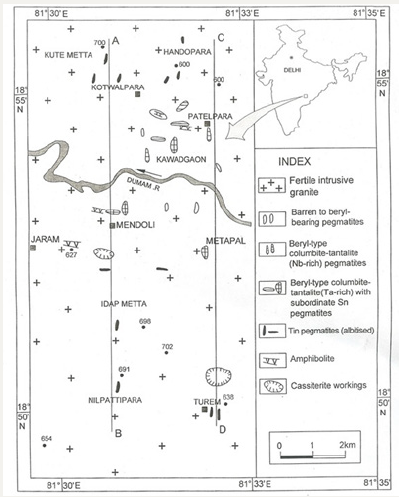
Figure 3:Geological cross section along A-B and C-D (Figure 1) showing disposition of rare metal and tin pegmatites in the Kawadgaon area [5].
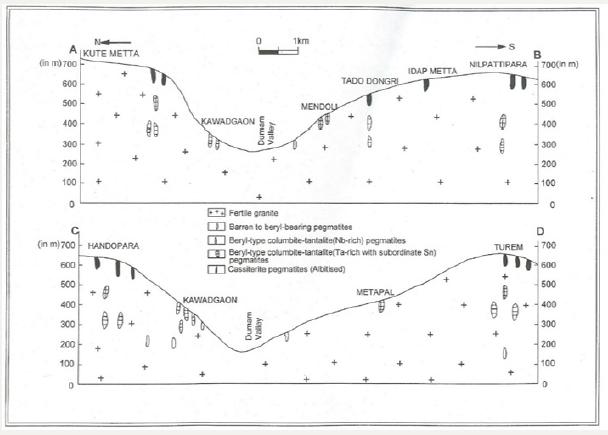
Figure 4:Field photographs from in and around Kawadgaon area.
Figure 4a: Unzoned pegmatite occurring as veins within biotite granite, some pegmatites also occur as fracture fillings. Note intersection relationships of unzoned pegmatite veins, with younger ones (mostly filling fractures) dislocating the older ones.
Figure 4b: Pegmatitic granite.
Figure 4c-4e: Zoned rare metal pegmatite showing 2-3 distinct zones, namely, Quartz Core (QC), Perthite Zone (PZ) and Intermediate Zone (IZ). Fourth zone, that is, wall/border zone is not visible in the photo. In IZ, quartz, perthitic and non-perthitic microcline, and muscovite are present.
Figure 4f: Geological map of a rare metal pegmatite emplaced in metabasic rock occurring within the 2.5Ga ore-bearing granite.
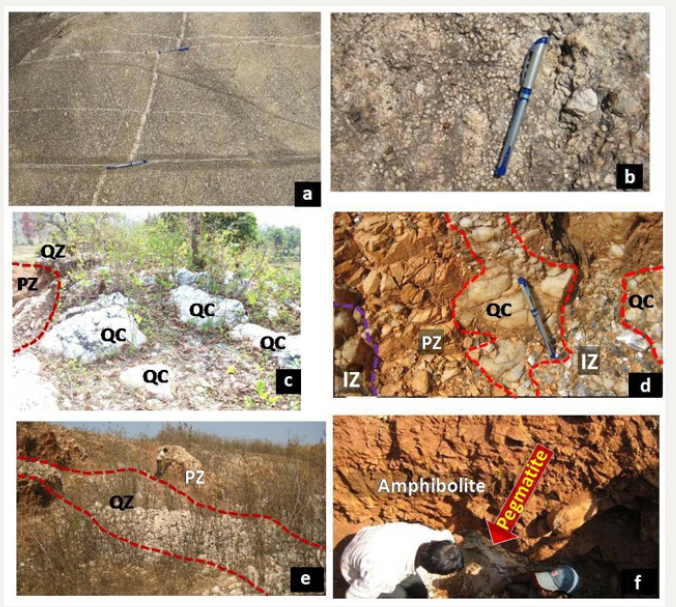
Petrography and mineralogy
The granites are mesocratic to leucocratic, and medium to coarse-grained. Under the microscope, the granites exhibit mostly hypidiomorphic granular texture (Figure 5a) and, at places, myrmekitic and granophyric textures, besides graphic intergrowth of quartz and microcline. The granites comprise chiefly of quartz, microcline, perthite, albite-oligoclase, with muscovite, biotite (Figure 5b,5c), hornblende (rare), sericite, and chlorite as accessories, besides xenotime, monazite, zircon, rutile, sphene, ilmenite, magnetite, zoisite and clinozoisite. Quartz shows signs of strain. Dominance of primary muscovite over biotite (Figure 5b) in granites suggests them to be of peraluminous nature. Laths of primary muscovite, at places, show distinct contact with the perthite and microcline. It exhibits high order interference colour. Biotite laths are brownish and contain innumerable pleochroic haloes around tiny monazite grains. Chloritisation of biotite is also noted commonly (Figure 5c). Occasionally, granites show postcrystallisation modification of feldspar and mica suggesting that they have been influenced by younger secondary processes (Figure 5d). These incipient modifications are of hydrothermal origin due to late phase metasomatism and attendant mineralization of rare metal and /or rare earths. At places, yellowish monazite grains are also present (Figure 5d). Pegmatites show evidences of greisenisation and albitisation. Greisenised pegmatites show aggregates of muscovite, topaz, and quartz. Albitisation is marked by the development of cleavelandite and sugary albite. In both the cases, tiny grains of albite occasionally show polysynthetic twinning. Occasionally, relict patches of perthite are preserved within the sugary albite.
Figure 5:Microphotographs of ore-bearing granites showing:
Figure 5a: Hypidiomorphic granular texture.
Figure 5b: Two-mica type nature with muscovite (M) and biotite (B), with a dominance of M over B.
Figure 5c: Alteration of biotite in to chlorite.
Figure 5d: Monazite (Mz) grains with muscovite (M) and Incipient Modification (IMF) of its constituent minerals. IMF may be linked with hydrothermal activity due to late phase metasomatism responsible for kaolinisation and/albitisation and attendant mineralization. Note yellow-coloured, Euhedral Monazite (Mz) crystal with dotted brownish pigmentation lines.
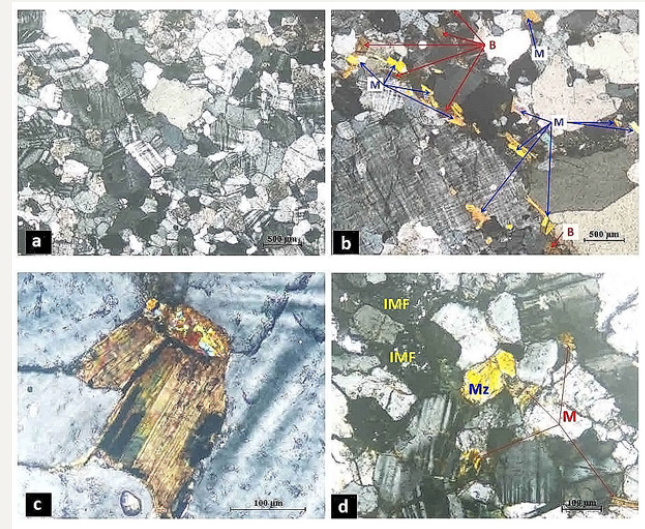
Abundance of ore minerals in granites is less. Various ore minerals observed are beryl, columbite-tantalite, monazite, xenotime, and ilmenite. Beryl occurs as tiny euhedral crystals, occasionally measuring up to 5cm long. Other ore minerals are small in grain size and have been noted in heavy mineral concentrates recovered from granites after their crushing and heavy media liquid separation, followed by isodynamic magnetic separation. In pegmatites derived from these granites, diversified mineral assemblage has been noted. The ore minerals observed are columbite-tantalite, ixiolite, pseudo-ixiolite, wodginite, microlite, fersmite, euxenite, aeschynite, beryl, cassiterite, monazite, xenotime, zircon, ilmenite, triplite, and magnetite (all identified by x-ray diffraction studies) [17,18]. Among these, columbite-tantalite, ixiolite, wodginite, beryl, and cassiterite are widespread, and are commercially exploitable [18]. In fact, so far, from Kawadgaon and adjoining areas about 150,000 tonnes of RMRE-bearing ores have already been mined, and still more than this quantity of the ore is available for mining. Associated gangue minerals are represented by quartz, microcline, perthite, albite (and its variants cleavelandite and sugary albite), muscovite, biotite, sericite, almandite, illite, and kaolinite. Microcline perthite and microcline are the main feldspar. The albitised pegmatites contain grey, white, and earthy albite. Due to pervasive albitisation, microcline perthite has been almost completely replaced by albite. It is milky white with ash grey tinge and occurs as cleavelandite and/or equigranular saccharoidal aggregates of sugary albite.
Geochemistry of ore-bearing granites
The average geochemical data of various granitic bodies reveals SiO2 71.79-75.01%, Al2O3 12.71-14.78%, total (Na2O+K2O) 7.93- 8.66%, CaO 0.65-1.00%, TiO2 0.15-0.39%, MnO 0.02-0.27%, P2O5 0.08-0.26%, Rb 283-425ppm, Zr 136-271ppm, Nb 30-44ppm, Y 18-58ppm, Ba 456-679ppm and Sr 72-121ppm (Table 1). Most of the granites are high-K type, with a lesser number of samples falling in the low-K to medium-K types. Chemically, although the granites show a transition from adamellite to granite, with most of them having a K2O/Na2O ratio>1, the bulk of granites fall in the compositional field for granite. The granites are highly peraluminous (A/CNK ratio>1; 1.05 - 1.25), and distinctly enriched in Rb,Y,Nb,Pb and depleted in Sr and Ba. In terms of the molar A/ CNK vs. A/NK plots [19,20], the granite falls in the field for S-type granites, which is further corroborated by the values of alumina saturation index (ASI, molar A/(C+N+K). The available geochemical data indicates that the peraluminous pluton was appreciably influenced by feldspar fractionation [10,18].
Table 1:Average composition (Oxides in Wt.% and trace elements in ppm) of ore-bearing granitic bodies of Darba, Paliam, Metapal [10] and Kawadgaon [18] areas of Bastar craton, central India.
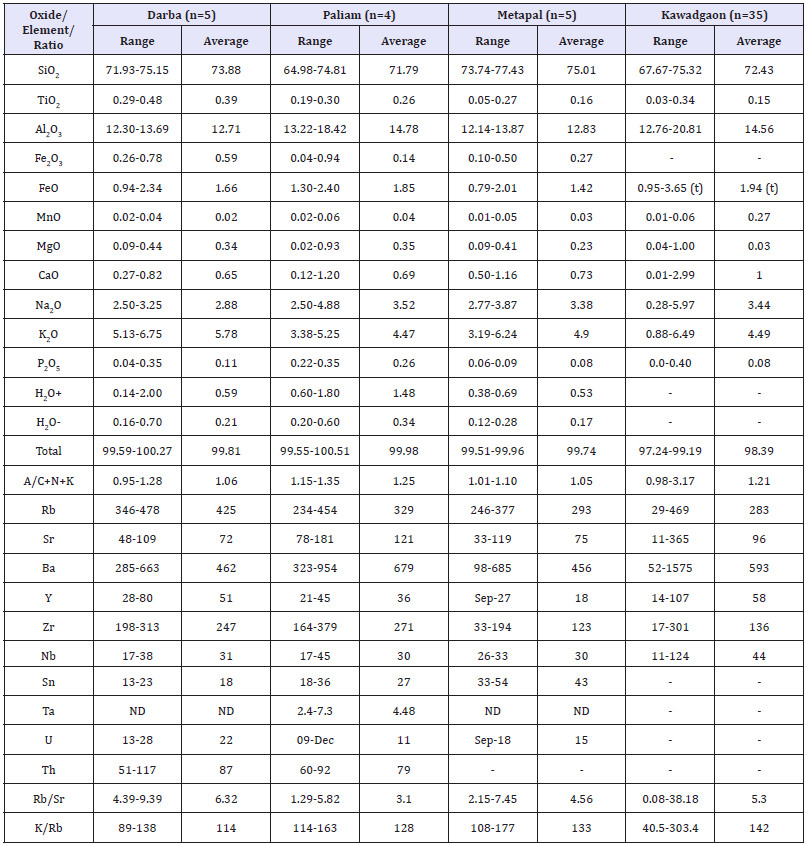
The concentrations of large ion lithophile elements in the granites (average) are 283-425ppm Rb, 72-121ppm Sr, and 456- 679ppm Ba. When compared with the abundances of Rb (170ppm), Sr (100ppm), and Ba (400ppm) in the average low Ca-granite [21,22], the granites show enrichment in Rb, and depletion in Sr, a fact further supported by spider plots of granites (Figure 6) [23]. The granites have K/Rb ratios of 114-142 and Rb/Sr ratio of 3.1- 6.32 (Table 1).
Figure 6:Primordial mantle normalized spidergram of ore-bearing granites from Kawadgaon. Normalising values after Wood et al. [23].
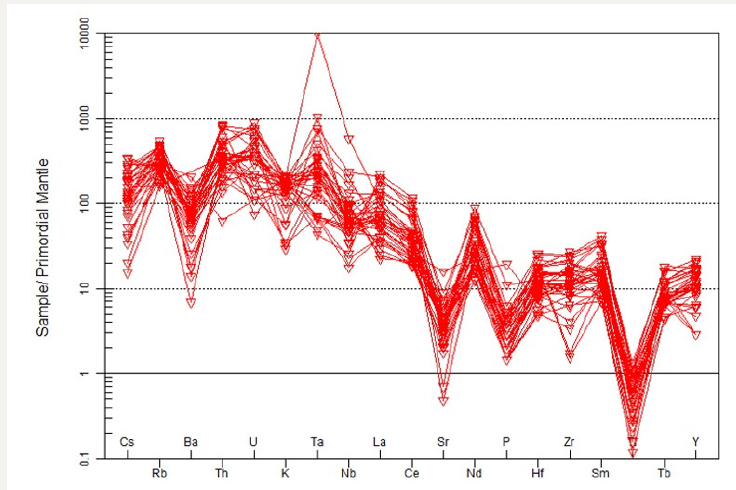
Discussion
Mineralogical data reveals that the granites are mostly a twomica (biotite and muscovite) type. The key geochemical features of the granites are their sub-alkaline and strongly peraluminous (A/ CNK ratio=1.05 to 3.17; av. 1.27) nature. Also, the granites have a high K/Na ratio and high silica, total alkalies and Rb contents. These mineralogical and geochemical characteristics of the granites suggest a crustal origin [24,25]. The available high initial 87Sr/86Sr isotopic ratio (0.7142) of the granite [14] also indicates that it has been derived from the reworking of the older crustal rocks. Interestingly, mol. CaO/(MgO+FeOt) vs. mol. Al2O3/(MgO+FeOt) plots [26] of granites also suggest the involvement of metapelite and metagreywacke sources in the generation of the magmas. These inferences are coherent with the fact that, similar to the granites of Bastar craton, the biotite-granite and muscovite-biotite granites are also known to be purely crustal-derived granites that are closely associated with the melting of crustal metasedimentary and/or TTG (trondhjemite, tonalite, granodiorite) suite of rocks [27].
Conclusion
Petromineralogical and geochemical studies on ore-bearing granites and pegmatites of the Bastar craton, central India leads to the following conclusions.
1. The ore-bearing granites comprise chiefly of quartz, microcline, perthite, albite-oligoclase, with muscovite, biotite and (secondary) hydrated muscovite, sericite, and chlorite as accessories. In addition, monazite, xenotime, zircon, rutile, sphene, ilmenite, magnetite, zoisite, and clinozoisite are also present. The dominance of primary muscovite over biotite suggests that the granites are peraluminous.
2. Ore minerals associated with pegmatites are columbitetantalite, ixiolite, pseudo-ixiolite, wodginite, microlite, fersmite, euxenite, aeschynite, beryl, cassiterite, monazite, xenotime, zircon, ilmenite, triplite, and magnetite
3. Chemically, the bulk of granites fall in the compositional field for granite. The granites are highly peraluminous, S-type, and distinctly enriched in Rb,Y,Nb,Pb and depleted in Sr and Ba.
4. The high initial 87Sr/86Sr isotopic ratios and mol. CaO/ (MgO+FeOt) vs. mol. Al2O3/(MgO+FeOt) plots indicate that the granitic bodies were derived from the reworking of the older crustal rocks involving metapelite and metagreywacke.
5. A major part of the granites were formed from fractionated melt, whereas further fractionation of melt led to the formation of pegmatites and attendant rare element mineralization.
Acknowledgement
I thank Prof. Vinod K. Singh for his kind invitation to contribute for edited book ‘Earth Crust Evolution: From Precambrian to Recent’; to an anonymous reviewer for insightful reviews and useful suggestions; and to M/s Archaeology & Anthropology Publishers for very prompt processing of manuscript and printing in most professional way.
References
- Deshpande ML (1976) The cassiterite-lepidolite-bearing pegmatites in the Bastar district, Madhya Pradesh. Ind Minerals 30(1): 67-74.
- Paul DC, Mishra B, Bemhardt HJ (2007) Mineralogy and geochemistry of pegmatite-hosted Sn-,Ta-Nb- and Zr-Hf- bearing minerals from the southeastern part of the Bastar Malkanjgiri pegmatite belt, central India. Ore Geol Review 30(1): 30-55.
- Singh Y, Rai SD, Sinha RP, Kaul R (1991) Lithium pegmatites in parts of Bastar Craton, Central India. Exploration and Research for Atomic Minerals 4: 93-108.
- Babu TM (1994) Tin in India: Mineral Resources of India Series7. Geol Soc India, p. 217.
- Singh Y (1998) Early Proterozoic rare metal and tin pegmatites near Kawadgaon, Bastar, M.P: An example of vertical pegmatite zonation. Jour Geol Soc India 51(2): 175-182.
- Singh Y (2007) Granitic Soil yttrium-cerium geochemistry with xenotime concentrate upgradation around Darba, Bastar district, Chhattisgarh. In: Pophare AM, Malpe DB (Eds.), Recent developments in geology and mineral resources of central India. Gond Geol Mag 10: 173-178.
- Singh Y, Singh KDP (2001) X-ray mineralogy and cerium-yttriumniobium- tantalum geochemistry of granitic soil from Muskel- Kawadgaon area, Bastar craton, central India. Indian Minerals 55: 47-54.
- Crookshank H (1963) Geology of southern Bastar and Jeypore from Bailadila ranre to Eastern Ghats. Geol Surv India Mem, USA.
- Ramakrishnan M, Vaidyanathan R (2008) Geology of India. Geol Soc India, India.
- Ramesh Babu PV (1999) Rare metal and rare earth pegmatites of central India. Exploration and Research for Atomic Minerals 12: 7-52.
- Singh Y (1999) Lithostratigraphic correlation of andalusite quartzites above the early Proterozoic granites intrusive into Bengpal and Sukma Groups in Gadapal-Jaram area, South Bastar, Madhya Pradesh. Gond Geol Mag 14(2): 1-9.
- Ramakrishnan M (1990) Crustal development in southern Bastar, central Indian craton: Precambrian of Central India. Geol Surv India Spl 28: 44-66.
- Sarkar G, Paul DK, De Laeter JR, McNaughton NJ, Mishra VP (1990) A geochemical and Pb, Sr isotopic study of the evolution of granitegneisses from the Bastar craton, central India. Journal of Geological Society India 35(5): 480-496.
- Singh Y, Chabria T (1999) Late Archaean-early Proterozoic Rb-Sr isochron age of granite from Kawadgaon, Bastar district, Madhya Pradesh. Jour Geol Soc India 54(4): 405-409.
- Pandey BK, Prasad RN, Veena K, Sagar S, Gupta JN, et al. (1989) Early Proterozoic Rb-Sr isochron ages fro the granitic rocks from parts of Koraput district, Orissa, India. Indian Minerals 43: 73-78.
- Yoshida M, Divi RS, Santosh M (2001) Precambrian Central India and its role in the Gondwanaland-Rhodinia context. Gondwana Res 4(2): 208- 211.
- Singh Y, Viswanathan R (2015) Rare metal and rare earth element mineral speciation in pegmatite belts of India: Implications for classification and genesis. Exploration and Research for Atomic Minerals 25: 105-133.
- Singh Y, Pandit PSC, Bagora S, Jain PK (2017) Mineralogy, geochemistry and genesis of co-genetic granite-pegmatite-hosted rare metal and rare earth deposits of the Kawadgaon area, Bastar craton, central India. Journal of Geol Soc India 89(2): 115-130.
- Maniar PD, Piccoli PM (1989) Tectonic discrimination of granitoids. Bull Geo Soc America 101: 635-643.
- Shand SJ (1927) Eruptive rocks. D Van Nostrand Company, New York, UK.
- Singh Y, Bagora S, Jain PK, Pandit PC, Mishra KS (2010) Rb, Sr and Ba geochemistry of coexisting granitoids-pegmatoids from the Kawadgaon- Challanpara area, Central India: Implications for rare-metal exploration. Jour Applied Geochemistry 12(2A): 447-456.
- Turekian KK, Wedepohl KH (1961) Distribution of the elements in some major units of the Earth’s Crust. Bull Geol Soc America 72(2): 175-192.
- Wood DA, Joron JL, Treuil M, Norry M, Tarney J (1979) Elemental and Sr isotope variations in basic lavas from Iceland and the surrounding ocean floor. Contri Mineral Petrol 70(3): 319-339.
- Calvin FM (1985) Are strongly peraluminous magma derived from politic sedimentary source? Jour Geol 93: 673-689.
- Chappell BW, White AJR (1974) Two contrasting granite types. Pacific Geology 8: 173-174.
- Altherr R, Holl A, Hegner E, Langer C, Kreuzer H (2000) High-potassium, calc-alkaline I-type plutonism in the Europian Variscides: Northern Vosges (France) and northern Schwarzwald (Germany). Lithos 50(1-3): 51-73.
- Laurent O, Paquette JL, Martin H, Doucelance R, Moyen JF (2013) LAICP- MS dating of zircons from Meso- and Neoarchean granitoids of the Pietersburg block (South Africa): Crustal evolution in the northern margin of the Kaapvaal craton. Precambrian Research 230: 209-226.
© 2018 Yamuna Singh. This is an open access article distributed under the terms of the Creative Commons Attribution License , which permits unrestricted use, distribution, and build upon your work non-commercially.
 a Creative Commons Attribution 4.0 International License. Based on a work at www.crimsonpublishers.com.
Best viewed in
a Creative Commons Attribution 4.0 International License. Based on a work at www.crimsonpublishers.com.
Best viewed in 







.jpg)






























 Editorial Board Registrations
Editorial Board Registrations Submit your Article
Submit your Article Refer a Friend
Refer a Friend Advertise With Us
Advertise With Us
.jpg)






.jpg)













.bmp)
.jpg)
.png)
.jpg)














.png)

.png)



.png)






